- EUR/USD tumbled to a fresh two-decade low and was pressured by a combination of factors.
- The energy crisis in Europe continued furling recession fears and weighed on the shared currency.
- The USD prolonged its recent bullish run and further contributed to the pair’s sharp downfall.
The EUR/USD pair witnessed heavy selling for the second successive day on Wednesday, marking the fifth day of a downfall in the previous seven and plunged to a fresh decade low. Recession fears remain the central theme in the markets, which, along with the energy crisis in Europe, cast a shadow over the region's economic outlook. This, in turn, continued undermining the shared currency, further pressured by softer domestic data. The Eurozone Retail Sales posted a modest 0.2% increase in May and German Factory Orders fell 3.1% during the reported month. Apart from this, strong follow-through US dollar buying exerted additional downward pressure on the major.
Against the backdrop of the worsening global economic outlook, aggressive Fed rate hike expectations assisted the safe-haven USD in prolonging its recent bullish run. The prospects for a faster policy tightening by the Fed were reaffirmed by the unsurprisingly hawkish minutes of the June 14-15 FOMC meeting. Policymakers emphasized the need to fight inflation even if it meant slowing an economy and indicated that another 50 or 75 bps rate hike is likely at the July meeting. This followed the release of better-than-expected US data on the services sector and the JOLTS Job Openings report. Adding to this, a goodish rebound in the US Treasury bond yields further boosted the buck.
The combination of factors contributed to the EUR/USD pair's decline, taking along some trading stops near the 1.0200 round-figure mark. Overstretched oscillators on short-term charts helped spot prices to find some support ahead of the 1.0150 region. Furthermore, a slight recovery in the risk sentiment held back the USD bulls from placing fresh bets and provided a modest lift to the major during the Asian session on Thursday. Traders now look forward to the German May Industrial Production figures for some impetus ahead of the US Weekly Initial Jobless Claims. The focus, however, would remain on the closely-watched US NFP report on Friday.
Technical outlook
From a technical perspective, the overnight swing low, around the 1.0160 region, now seems to act as a pivotal point, below which spot prices could extend the fall towards the 1.0100 mark. Some follow-through selling would make the EUR/USD pair vulnerable to challenging the parity mark in the near term.
On the flip side, the attempted recovery move is more likely to confront stiff resistance near the 1.0275-1.0280 region. This is closely followed by the 1.0300 round figure, which if cleared should lift the EUR/USD pair towards the 1.0350 support breakpoint, now turned resistance. Sustained strength beyond could trigger a short-covering move and allow bulls to reclaim the 1.0400 mark, though the momentum runs the risk of fizzling out rather quickly.






